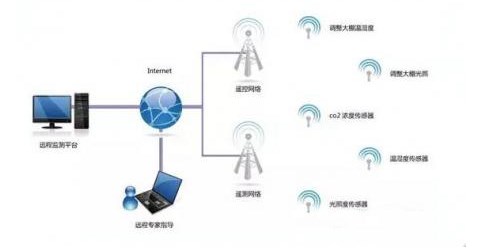Wireless sensor networks are widely used.The sensor node measures thermal, infrared, sonar, radar and seismic signals in the surrounding environment with its built-in sensors of various forms, as well as many physical phenomena of interest, including temperature, humidity, noise, light intensity, pressure, soil composition, size, speed and direction of moving objects.Sensor nodes have good cooperation ability and complete global tasks through local data exchange.
Due to the requirements of the node characteristics of the sensor network of the Internet of things, the multi-hop and peer-to-peer communication mode is more suitable for the wireline sensor network than the traditional single-hop and master-slave communication mode, and can effectively avoid the problems of signal fading and interference in the long distance wireless signal propagation.Through gateways, sensor networks can also connect to existing network infrastructure, transmitting the collected information back to remote end users.Wireless sensor network also has the following characteristics:

Network dynamics:
The topology of sensor networks may change due to the following factors:
(1) sensor node failure or failure caused by environmental factors or power consumption;
(2) changes in environmental conditions may cause changes in the bandwidth of wireless communication links, or even intermittent;
(3) sensor, perceived object and observer in sensor network may have mobility;
(4) join the new node.This requires the sensor network system to be able to adapt to this change, with dynamic system reconfigurable.
Network reliability:
Sensor networks are particularly suitable for deployment in harsh environments or areas not suitable for human beings to reach. Sensor nodes may work in the open environment, suffer from the sun or wind or rain, or even be damaged by unrelated people or animals.Sensor nodes are often deployed randomly, such as by aircraft seeding or firing "gun Dan" into designated areas for deployment.
All of these require sensor nodes to be very strong, not easy to damage, adapt to a variety of harsh environmental conditions.Due to the limitation of monitoring regional environment and the huge number of sensor nodes, it is impossible to "care" each sensor node manually, and the maintenance of the network is very difficult or even impossible.The communication confidentiality and security of sensor network are also very important to prevent the theft of monitoring data and false monitoring information.Therefore, the hardware and software of sensor network must be robust and fault tolerant.
Data-centric:
Sensor networks are task-based networks, so it is meaningless to talk about sensor nodes without sensor networks.The nodes in the sensor network are marked by node number. Whether the node number needs the whole network depends on the design of network communication protocol.Due to the random deployment of sensor points, the relationship between the sensor network formed and node number is completely dynamic, which shows that there is no inevitable relationship between node number and node location.When users use sensor network to query events, they directly inform the network of the events they care about, rather than inform a certain numbered node.The network receives information about the specified event and reports it to the user.
The idea of using the data itself as a query or transmission cue is closer to the habit of natural language communication.So sensor networks are generally said to be data-centric networks.For example, in the sensor network applied to target tracking, the tracking target may appear anywhere. Users who are interested in the target only care about the location and time of the target, and do not care which node detects the target.In fact, in the process of moving the target, it must be different nodes to provide the location information of the target.
Apply relevant networks
Sensor network is used to perceive the objective physical world and obtain the information of the physical world.There are many kinds of physical quantities in the objective world.Different sensor network applications are concerned with different physical quantities, so there are various requirements for sensor application systems.Different application backgrounds have different requirements for sensor networks, and their hardware platforms, software systems and network agreements are bound to be very different.Therefore, sensor networks cannot have a unified communication protocol platform like the Internet.
Although there are some common problems for different sensor network applications, more attention is paid to the differences of sensor networks in the development of sensor network applications.Only by making the system closer to the application can we achieve the most efficient target system.Research on sensor network technology for each specific application, which is a significant feature of sensor network design different from traditional network.
Wireless sensor network can be used in fine agriculture to monitor pests in crops, soil acidity and fertilization.It could also track the migration of migratory birds and insects, study the impact of environmental changes on crops, and monitor the composition of the oceans, atmosphere and soil.

 Английский
Английский  Китайский
Китайский  Немецкий
Немецкий  Корейский
Корейский  Японский
Японский  Farsi
Farsi  Portuguese
Portuguese  Russian
Russian  Испанский
Испанский 





